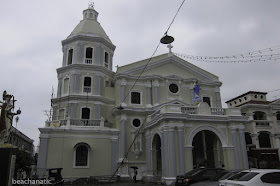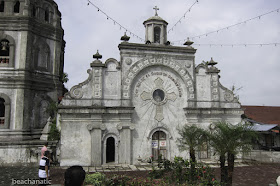This post
would feature five parish churches and one chapel in Pampanga. They are the
following: the Metropolitan Cathedral of San Fernando, the Arzobispado Chapel,
the San Guillermo Parish Church of Bacolor, the
parish church of Betis, the San Agustin parish church of Lubao and the
Sta. Catalina de Alejandria parish church of Porac.
METROPOLITAN CATHEDRAL OF SAN FERNANDO
SAN FERNANDO, PAMPANGA
Founded: 1754
The town of
San Fernando was founded by the Augustinians in 1754. The church was built in 1756 by Fr. Sebastian
Moreno and completed by Fr. Mariano Alafont in 1781. In December 11, 1948 San
Fernando was created as a diocese and the church of San Fernando became the
Cathedral Church. The church is dedicated to Our Lady of the Assumption but
its primary patron is St. Ferdinand, King.
 |
| The Cathedral of San Fernando, Pampanga. |
 |
| Newly repainted Cathedral Church of San Fernando. |
 |
| The dome with octagonal designs. |
 |
| The pulpit. |
 |
| Installation of the new Archbishop of San Fernando: Abp. Florentino Lavarias on October 27, 2014. |
 |
| The statue of San Fernando outside of the Cathedral. |
ARZOBISPADO CHAPEL
San Fernando, Pampanga
 |
| The Chapel at the Arzobispado in San Fernando, Pampanga. |
 |
| Interior of the Arzobispado chapel. |
SAN GUILLERMO PARISH CHURCH
BACOLOR, PAMPANGA
Founded:1576
The church
of Bacolor dedicated to San Guillermo as its patron saint was originally
constructed by the Augustinians in 1576. It was destroyed I 1880 by an
earthquake only to be rebuilt in 1886.
In September 3, 1995 lahar flow from the slope of Mt. Pinatubo which
erupted four years before on June 15, 1991 buried the church at half its twelve
meter height prompting its more than fifty thousand residents to evacuate to
safer grounds in resettlement areas. The
retablo was dug out from the lahar and in order to add more height, the ceiling
was removed.
 |
| The present doors where actually the arched windows on the second level of the church. |
 |
| The retablo was dug out from the lahar and restored to its present state. |
 |
| The side altars were likewise dug out from the lahar that covered them. |
 |
| The half buried church of Bacolor. |
 |
| The old convento now serves as a museum. |
SANTIAGO APOSTOL PARISH CHURCH
BETIS, GUAGUA, PAMPANGA
Founded: 1660
The town of
Betis was founded by the Augustinians in 1660 with St. James the Apostle as its
patron saint. It is a town of master carvers.
This talent was used in the different artworks found in the church like the
ornately carved designs of the retablo and the stations of the cross. The mural paintings on the ceiling was extensively
done in 1939 under the last Spanish friar who served as parish priest, Fr.
Santiago Blanco, OSA. Native painter Macario Ligon was commissioned to do the
painting. Later in the 70s and early 80s, his nephew Victor Ramos would restore
80 percent of the mural paintings as the wooden panels were already decaying
due to termite infestation. Because of migration, the town of Betis would be
merged with the town of Guagua in 1904. The church of Betis was declared as a national
cultural treasure in 1972.
 |
| Mural paintings on the ceiling of the church. |
 |
| Carved Stations of the Cross. |
 |
| Ornately designed and carved retablo. |
 |
| The floor of the church is made of wood. |
 |
| Baptistery with a painting of the baptism of Jesus by John the Baptist. |
 |
| The dome is also filled with mural paintings. |
SAN AGUSTIN PARISH CHURCH
LUBAO, PAMPANGA
Founded: 1572
STA. CATALINA DE ALEJANDRIA PARISH CHURCH
PORAC, PAMPANGA
Founded: 1611
 |
| St. Catherine of Alexandria. |
What is a Pilgrimage?
A pilgrimage is a journey for a
spiritual reason. It is a journey inward as well as outward. Pilgrims seek to
strengthen and renew their faith through travel – a sacred travel. Travel in
the context of pilgrims becomes a sacrament. Travel to a sacred place is the
outward sign that enables the drawing closer to God which is the inward grace.
This is the difference between a pilgrim and a tourist. For a tourist, travel
is an end in itself. For a pilgrim, travel is a means to an end. Pilgrims
travel with a clear intention, to draw closer to God. The life of a Christian
is seen as the lifetime pilgrimage towards the heavenly home. Procession
actually and fittingly signifies this life’s pilgrimage.


























































No comments:
Post a Comment